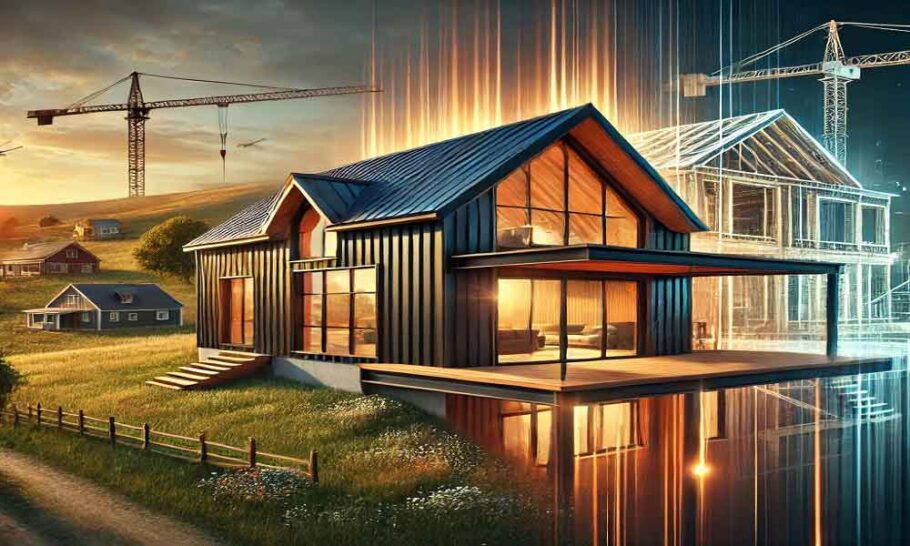Barndominiums have taken the residential construction world by storm in recent years, blending rustic aesthetics with modern design. But what happens when a barndominium starts to age, or when an old barn or metal structure is converted into a residence? That’s where barndominium retrofitting comes into play.
Retrofitting a barndominium is about more than just adding insulation or updating finishes—it’s about reimagining the potential of an existing structure and bringing it up to modern standards of comfort, efficiency, and design. In this blog post, we’ll take a deep dive into what barndominium retrofitting entails, the reasons to do it, and how to approach such a project successfully.
What Is Barndominium Retrofitting?
At its core, retrofitting refers to the process of modifying an existing building or structure to improve its performance, function, or aesthetic. In the context of a barndominium, this often means taking an older barn, metal building, or outdated barndominium and upgrading it—whether to meet modern building codes, improve energy efficiency, or adapt it to new living requirements.
Retrofitting can include:
- Structural reinforcement
- Upgrading insulation and weatherproofing
- Installing new HVAC, plumbing, and electrical systems
- Replacing roofing or siding
- Enhancing the layout for better flow or accessibility
- Modernizing the interior finishes and appliances
Whether you’re dealing with an old agricultural barn or a barndo built 20 years ago, retrofitting can breathe new life into a structure with character and history.
Why Retrofit a Barndominium?
There are many reasons why homeowners or investors may choose to retrofit a barndominium. Some of the most common motivations include:
- Upgrading Outdated Systems
Older barndominiums may have aging HVAC, plumbing, or electrical systems that are no longer efficient or even up to code. Retrofitting offers the chance to bring these systems into the modern age, improving safety and comfort.
- Improving Energy Efficiency
Many older metal structures were not designed with energy efficiency in mind. Without adequate insulation or energy-efficient windows, heating and cooling costs can soar. Retrofitting allows homeowners to improve thermal performance and reduce utility bills.
- Changing Functional Use
You may want to convert an old barn into a residence or turn a single-family barndominium into a multi-family dwelling. Retrofitting allows you to alter the space’s function and layout without a complete rebuild.
- Meeting New Code Requirements
Building codes evolve over time. If your barndominium was built years ago, it may not meet current safety, structural, or energy codes. Retrofitting ensures compliance and can prevent legal issues down the road.
- Boosting Property Value
A retrofitted barndominium with updated features and improved curb appeal can significantly increase property value, especially in hot rural and suburban real estate markets.
Common Retrofitting Strategies
Retrofitting can be as simple or complex as needed, depending on the goals and existing conditions of the structure. Here are some of the most common upgrades made during barndominium retrofitting:
- Structural Reinforcements
Older barns or metal buildings might need reinforcement to handle residential loads, such as additional framing for walls, stronger foundation support, or added trusses to handle heavier roof materials. Structural integrity is a top priority, especially when converting non-residential buildings into livable homes.
- Insulation and Weather Sealing
Many barns were never insulated or weather-sealed, making them inefficient and uncomfortable for full-time living. Spray foam insulation is a popular retrofitting solution, offering excellent R-values and moisture protection for metal buildings.
Other weatherization efforts include:
- Installing vapor barriers
- Sealing around doors and windows
- Upgrading to energy-efficient windows and doors
- Roofing Upgrades
Metal roofs are durable but can deteriorate over time or become noisy during rain or hail. Retrofitting may involve replacing the roof or adding an insulated underlayment to improve energy efficiency and soundproofing.
- Interior Remodeling
Retrofitting is often the perfect time to rework the layout of the space. Open concepts can be enhanced, or rooms can be added for more functional living. Other interior retrofits include:
- New drywall or interior wall finishes
- Updated flooring
- Modern kitchen and bathroom fixtures
- Better lighting systems and controls
- Smart Home Integration
Older barndominiums often lack modern conveniences like smart thermostats, lighting, and security systems. Retrofitting allows these features to be integrated seamlessly.
Challenges in Barndominium Retrofitting
Retrofitting offers tremendous opportunities—but it’s not without its challenges. Here are some common obstacles you may encounter:
- Hidden Damage
Older structures, especially barns, can hide issues like termite damage, rust, rot, or foundation settling. A thorough inspection is critical before beginning any work.
- Limited Access to Utilities
If you’re converting a rural barn into a barndominium, access to municipal water, sewage, or electrical systems may be limited. You may need to install a septic system or bring in utilities from afar.
- Permitting and Zoning Hurdles
Depending on where you live, converting a barn into a home may require a change in zoning or special permits. Be prepared to navigate some red tape.
- Structural Constraints
Not all barns were built with residential use in mind. Ceiling heights, load-bearing walls, and door placements may limit your design options unless significant structural changes are made.
- Cost Overruns
Retrofitting can be unpredictable. Unexpected issues can lead to added labor and materials costs. A strong contingency budget is essential.
Tips for a Successful Barndominium Retrofit
If you’re planning to retrofit a barndominium—either as a DIYer or with professional help—here are a few tips to ensure a successful outcome:
- Start with a Thorough Assessment
Hire an experienced contractor or structural engineer to inspect the existing structure before making plans. They can identify potential hazards, code compliance issues, and feasibility concerns.
- Plan for the Long Term
When retrofitting, think beyond your immediate needs. Consider how your lifestyle might change over the next 10–20 years and design accordingly. For example, consider adding aging-in-place features if this will be your forever home.
- Invest in Insulation and Energy Efficiency
Even if you’re on a tight budget, prioritize insulation, HVAC upgrades, and energy-efficient windows. These investments pay off over time in comfort and utility savings.
- Work with Experienced Professionals
Retrofitting metal buildings or barns is a specialized skill. Work with designers and contractors who have experience with barndominiums and understand the quirks of converting agricultural or industrial buildings into residences.
- Use 3D Design Tools or CAD Plans
Before you start swinging hammers, use 3D modeling software or work with a designer who can create visual renderings. This helps you avoid costly mistakes and visualize the flow of the space.
Final Thoughts
Barndominium retrofitting is a rewarding process that allows you to blend the character of old buildings with the comforts of modern living. Whether you’re restoring a century-old barn or updating a dated metal home, retrofitting is your opportunity to create something unique, functional, and tailored to your lifestyle.
With proper planning, a strong design vision, and the right team of professionals, you can transform even the most weathered structure into a beautiful, energy-efficient barndominium that will last for generations.

